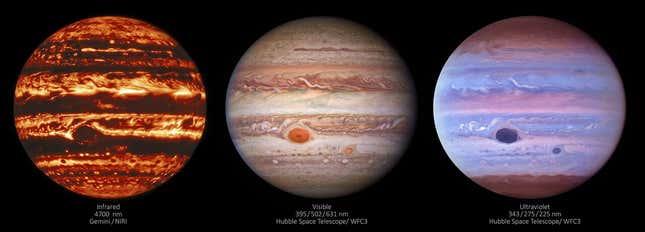
Though named for the Roman riff on Zeus, the planet Jupiter looks every bit a happy home for Hades in an infrared image (below) captured by the Gemini North telescope of Mauna Kea’s Gemini Observatory. Meanwhile, the Hubble Space Telescope produced a lovely ultraviolet view of the planet. These contrasting images are a reminder that the visible spectrum tells only part of the story when it comes to objects in outer space.
Taken in January 2017, the three images capture Jupiter in three different lights: infrared, visible, and ultraviolet. They highlight atmospheric details of the largest planet in our solar system, offering insights into the formation of lightning storms there and revealing gaps through which researchers can peer deeper into the planet’s gassy recesses. Pockmarks are visible in the planet’s iconic Great Red Spot and remain a bit of a mystery—perhaps they’re gaseous eddies, as described in a recent NOIRLab post.

The visible light image is no doubt familiar, a milky swirl of whites, peachy oranges, and matte reddish ringlets. This view shows us more ordinary areas of interest, like the planet’s superstorms and hot spots, in vivid color thanks to the unique chemical cocktail that makes up the planet’s outer atmosphere. But in the infrared image, the Great Red Spot becomes a black blot, white clouds become dark, and its ordinarily deep-red gas layers become bands of fire. The final image was taken in the ultraviolet spectrum and resembles the sort of planet you’ll see painted on the wall of a laser tag arena: a dazzling cotton candy orb.
Seeing the planet’s different cloud layers in finer resolution is an asset to planetary scientists, and for the casual observer, it’s a feast for the eyes.